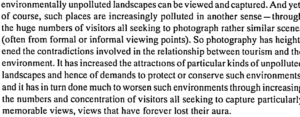The Dilemma of Too Many Tourists
Progymnasmata: Proverb
Creating an analogy between pollution and overcrowding is a fantastic way of exemplifying some of the difficulties with places of interest. While there may be nothing wrong with a particular destination the messy masses can often be a struggle. That being said the messy masses can be an integral part of an experience. Regardless, overcrowding is definitely a form of pollution.
Urry makes two contradictory points on the influx of people wanting to see a particular sight. One stating that an excess of people can pollute that area even more just by having more visitors. The other is that an influx of people can help protect special places. While contradictory both points are essential to understanding the impacts of too many people, especially when it comes to wildlife tourism. An influx of tourists can cause more trash in a river but that interest can also cause governmental protection of said river. Protection is important to save ecosystems, beautiful sights, environments like parks that benefit public health, and more. It is a balancing act, finding how many people is too many, and how many is not enough.
A great example for this dilemma would be the protection of the desert southwest along with the increase in industrial tourism. There are lots of National Parks in the desert southwest protecting canyons, arches, sand dunes, and more magnificent natural creations. The protection of these areas allows more people to access them and benefit from their wonders. On the other hand, the influx of tourists have caused crowds and infrastructure that can take away from the experience, and brings in litter, cars, infrastructure and more. Part of the magic of the desert is the solitude and sense of nature, but with an almost Disney esq. visitor center in Zion and hundreds of people it is hard to experience those qualities of the desert.
It is important to understand both points because it mitigates arrogance. I have felt connected to the desert traveling to very unknown places on river trips growing up. So to see the industrial tourism in these areas hurts my heart because it is such a special place. Especially when the people visiting are disrespectful of the environment through littering and other rude actions. BUT these places that I love would not have the maintenance, or the protection they have if they stated secret and unknown. Arches would be defaced, a McDonald’s could sit two feet from the Grand Canyon, an oil drill could destroy my favorite landscape. I also live in a tourist dependent town, Aspen, Colorado and without tourists my town would cease to exist. Tourists in both places make areas like Zion National Park or Eric’s Bar undesirable in my opinion, but both are interesting places I would recommend many people visit. There are still special wonderful “secret” areas I can enjoy, plus the fascinating places people are curious about.


